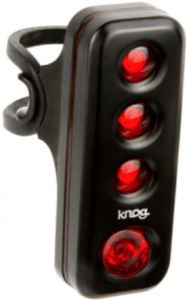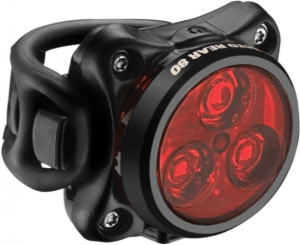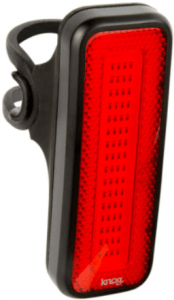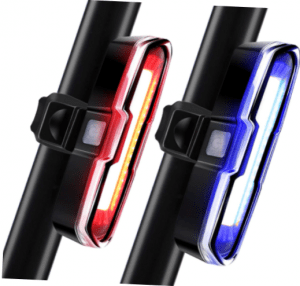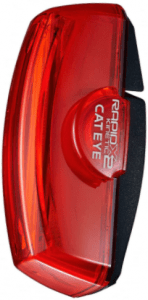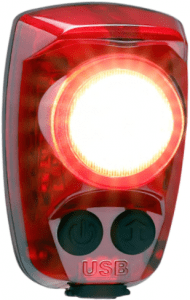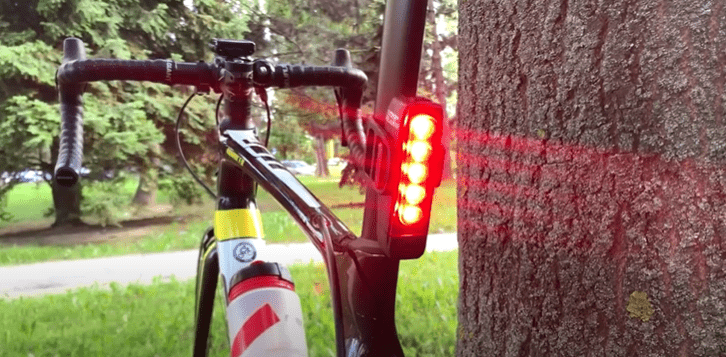

THE TOP
FIVE
Every cyclist should have taillights on their bike, particularly if they ride on roads or in urban areas. Even those who venture out into the mountains or ride on gravel during nighttime hours will require lighting to ensure a safe experience.
Not having taillights on your bike may seem insignificant, but it can have serious implications. For example, if you don’t have any lights and an emergency vehicle hits you while you’re cycling at night (which is illegal!), they may assume that your bike is not functional because there are no flashing indicators.
The biggest issue with not having proper lighting is the lack of visibility, especially during dusk or dawn hours. Cyclists need effective warning systems so that drivers can see them and avoid turning or hitting them.
If you’re looking to choose the perfect rear light for your bike, consider the following factors. This article will help you identify the key features to look for and emphasize the importance of having one.
If you’re a demanding cyclist who values safety and freedom while riding, these taillights are perfect for you. They feature an elegant and sturdy design that’s ideal for road cycling.
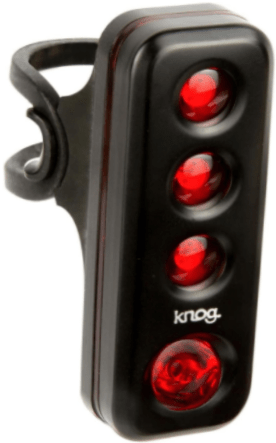

One of their standout features is the Cree XB Led, which provides ample side lighting, along with three incredibly bright LED lights. The battery can be easily recharged via USB, with a runtime of up to 3 hours in constant mode and 20 hours in intermittent mode.
These taillights have 5 different high power modes, allowing you to adjust to the lighting conditions you’re riding in. The highest mode provides exceptional visibility up to 1 km away, perfect for nighttime adventures.
They’re also compatible with aero posts and come with three interchangeable bands that fit snugly onto your bike’s Seatpost. With a maximum output of 70 lumens and guaranteed waterproofing, the Knog Blinder Road is easy to install and weighs just 28 grams.
PROS
CONS
These taillights provide excellent visibility with their three super-bright LEDs, making it safe to ride your bike at night. They also feature a movement detection system that automatically turns off the light after 3 minutes of inactivity and turns it back on when movement is detected. The battery life ranges from 3 to 11 hours, depending on the mode of operation you choose.
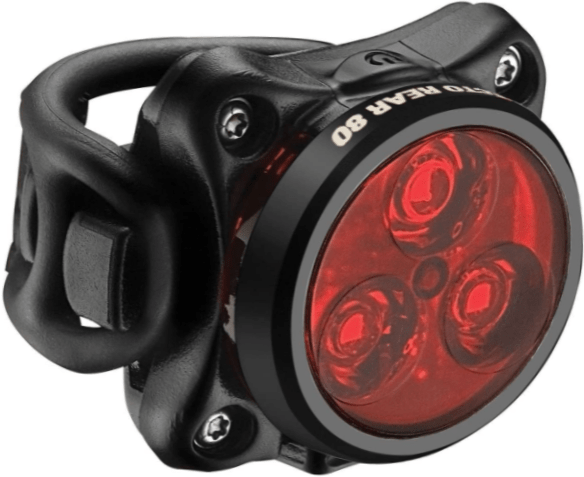

Made from Matrix composite, these taillights are lightweight and come with an aluminum bezel that offers 180º of lateral visibility, significantly increasing your safety while cycling at night. You can charge them with a Micro USB cable, and their power indicator lets you check the battery level.
The Lezyne Zecto Drive taillights consist of five LEDs that offer a powerful 250-lumen output. You can choose between nine combinations of lumens and flash modes, as well as a highly visible 250-lumen day flash mode.
They come with a Clip-On system that allows you to attach the light using its respective strap or clip mechanism. With an elegant black finish, the Lezyne Zecto Drive is highly resistant to the elements, including water.
PROS
CONS
The Blinder range of taillights is perfect for cyclists who want high light output. These taillights are slim, compact, and made of solid anodized aluminum with strong silicone straps. They come with three interchangeable straps that fit seat posts between 22mm and 35mm, including the Aero, and are easy to replace without any extra tools.
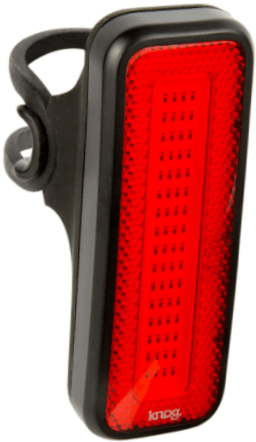

The taillights use COB technology, which integrates LED Chips Onboard, providing 44 lumens of light output and a visibility range of 120º. You will be visible not only from behind but also from the sides. With five different light modes, including constant high, constant low, strobe, flash, and echo flash, you can choose the one that suits your needs best.
To turn on your taillights, press for about 0.75 seconds, and to turn them off, press for 0.5 seconds. The taillights are rechargeable through a USB port and have a runtime of 2.5 hours in constant mode and up to 62 hours in intermittent mode.
The front of the Knog Blinder Mob Mr. Chips taillights is reflective, so if the battery runs out, you still have some visibility. The elegant design and replaceable straps make these taillights a great choice for any cyclist looking for a reliable and visible taillight.
PROS
CONS
These rear bike lights offer great value for their price range. They emit a powerful light of up to 110 lumens that can be easily dimmed as per your preference. Installation is hassle-free, thanks to the different rubbers provided.
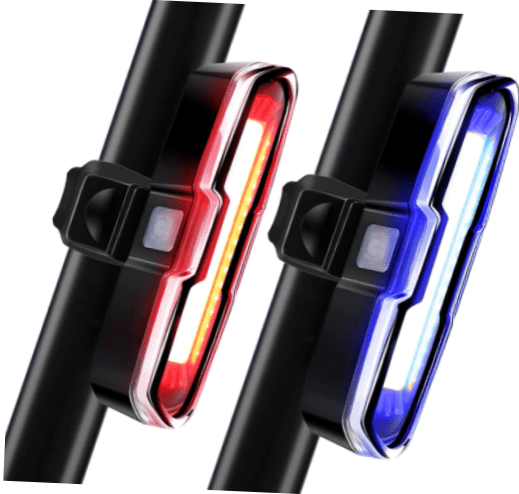

Their brightness makes them ideal for night-time rides, ensuring your safety as well as other drivers’. They feature four modes of operation – fixed white light, white strobe, red fixed, or red strobe.
Charging is done via USB, and it only takes about 2 hours to fully charge. Battery level indicator allows you to monitor the charging process. Once charged, these taillights can operate continuously for up to 4 hours in fixed white light mode, 8 hours in flashing white light mode, 12 hours in fixed red mode, and 25 hours in flashing red mode.
They are waterproof, so you can use them in any weather. Additionally, they are versatile enough to be used on backpacks, helmets, and even on your pet’s collar.
PROS
CONS
The Rapid X2 Kinetic taillights are a great investment for road safety, offering excellent motion sensitivity and visibility. With 50 lumens, the light is powerful enough to illuminate your path, making it easier for you to navigate your way home. The installation is quick and easy, requiring no extra tools.
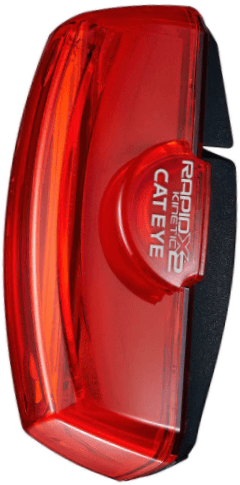

The Rapid X2 Kinetic has an integrated accelerometer that automatically switches to constant mode when it detects a sudden change in speed. This ensures that you are visible to other drivers and pedestrians. The taillight provides 180º visibility, making it easy for others to see you from all angles. It includes six different light modes that you can choose from depending on your needs.
The automatic battery-saving function helps extend the battery life, switching to an intermittent mode when the charge is low. This feature provides an additional hour of lighting, giving you extra time to get to your destination. The taillight can be recharged using a USB cable, which takes about 2 hours to charge fully. The battery life varies depending on the operating mode, with low mode lasting 5 hours, intermittent mode lasting 30 hours, and fast mode lasting 16 hours. The taillight also includes a battery level indicator to let you know when it’s time to recharge.
PROS
CONS
These tail lights may not have the sleekest design, but they provide sufficient brightness to keep you safe on the road. With a visibility range of over 100 meters, the Cygolite Hotshot Pro ensures that other drivers can easily spot you.
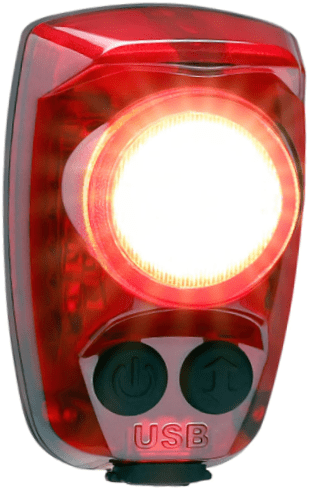

The device features three modes of operation: direct high, direct low, and intermittent red light, giving you the ability to adjust the angle of the light as needed. Additionally, it comes at an affordable price, making it an excellent option for those on a budget.
The Cygolite Hotshot Pro is rechargeable via USB cable, with a charging time of approximately 2 hours. It also has an indicator light that turns off automatically once the battery is fully charged. However, its battery life is relatively short, so it may not be the best option for long rides.
While it is made of water-resistant materials, this taillight may not withstand heavy rain. However, it provides good visibility in foggy weather conditions.
One potential downside of the Cygolite Hotshot Pro is that it may not hold up well on bumpy terrain, requiring frequent adjustments. The mode selection button may also be difficult to manipulate, especially if you are wearing gloves.
PROS
CONS
THINGS TO CONSIDER BEFORE BUYING BIKE TAILLIGHTS
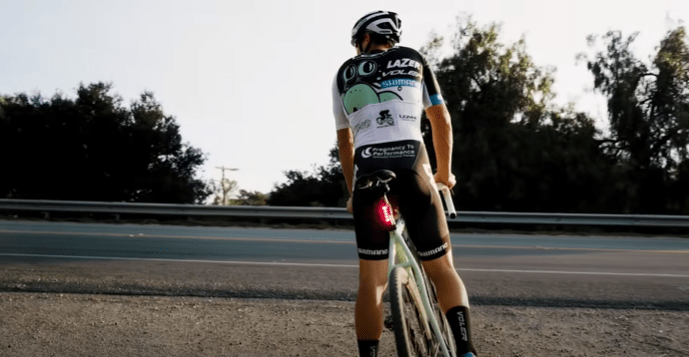

When it comes to cycling, safety should always be a top priority. One important aspect of bike safety is having a good taillight. Here are some tips to help you choose the best one for your needs:
The brightness of your taillight is crucial for visibility. Look for a taillight with at least 50 lumens to ensure that it is clearly visible day and night. Keep in mind that brighter lights will use more battery power than those with lower lumens.
Most reputable bike taillights today come with long battery life, especially those with rechargeable lithium-ion batteries. Expect up to 20 hours of battery life with regular use. If you’re on a budget, there are still bike taillights that are powered by replaceable alkaline batteries, but they are becoming less common.
LED lights are now the norm when it comes to bike taillights. They are brighter and longer-lasting than traditional light bulbs, and they don’t get hot. Look for LED lights for the best performance.
Consider a taillight with several mounting options to find the best location for your needs. Good mounting locations include near the Seatpost, saddle stays, or on top of a helmet or bike rack mount. Rubber strap mounts are versatile and can fit a variety of Seatpost shapes and sizes.
Choose a taillight that suits your driving needs. For simple trips around town, basic flashing lights with AAA batteries or button cells are cheap and effective. For longer trips or busy roads, look for brighter taillights with USB rechargeable AAA powered batteries.
The law allows for either blinking or steady lights, as long as the flash modes are between 1 Hz and 4 Hz. Blinking lights can make you more visible from further away, while steady lights can make it easier for following vehicles to judge the distance. Consider your needs and preferences when choosing a light mode.
Ensure that your taillight has enough visibility to be seen across the entire intersection, especially from the sides. Side visibility is especially important for two-wheeled vehicles.
Adjusting the level at which the light strikes can make a big difference in visibility. A higher angle ensures that other drivers notice you, but can be dazzling as they approach. A lower angle lights up the ground, making you less visible but avoiding dazzling others.
Look for a taillight with a button that allows you to turn the light on and off easily and select different lighting modes while riding, without distracting from the road.
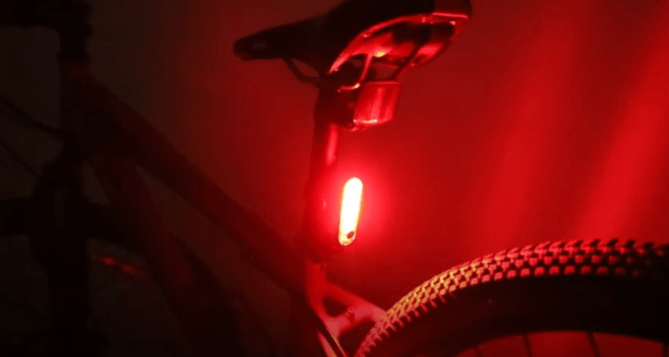

To start, bike taillights typically use batteries to operate for an extended period. There are two types: disposable battery-powered lights and rechargeable lithium-ion battery-powered lights that can be charged with USB cables.
Rechargeable battery-powered lights are more expensive, but using USB to charge them is a convenient option.
These lights are installed on the saddle bar of the bike at an appropriate height for visibility to other drivers. They come in different sizes and some models have adjustable rubber or silicone rings to fit different sizes of seat posts.
Most taillights have an on/off button and a mode selector to change the light beam frequency for safety.
The light is produced by LEDs powered by disposable or rechargeable batteries. The low electrical energy consumption of these small components, between 1V and 2V, allows for long-lasting charge.
The equipment is covered by good quality and durable plastic for optimal light refraction.
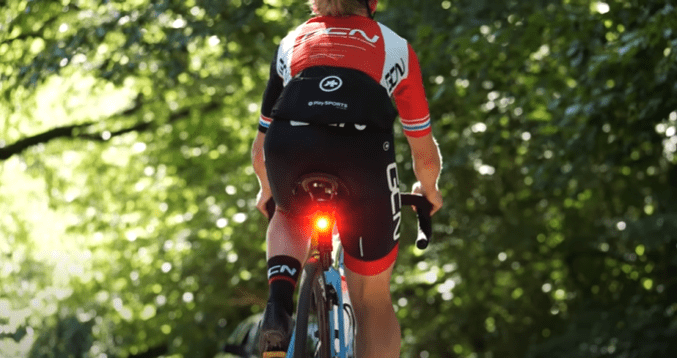

There are two main categories of taillights available in the market for bicycles. These categories depend on the environment in which the rider will use the bike and the type of lighting required. The two categories are:
These lights are designed to ensure the rider’s safety while riding in well-lit areas, allowing them to safely ride after dark. These lights can be used during the day but may not be practical for all users. It is important to check before purchasing to ensure the light meets your needs.
These lights emit their beams in multiple directions, lighting up the rear and the sides of the bike. Some lights provide a 180º angle of visibility, making the rider more visible to drivers on the side. They also have multiple light modes that make the rider more visible in traffic.
These lights are designed for night tours in areas where there is little to no lighting. The light they emit is more intense than urban taillights, and the cyclist requires this feature to be more visible in dark places.
Similar to urban taillights, they have different modes of intermittent light to make the rider more visible to others. They can be configured to emit long, medium, or short light. Their beams of light are directed towards the rear of the bike because they are designed for low-traffic roads, where the main concern is making the rider’s presence known to drivers behind them.
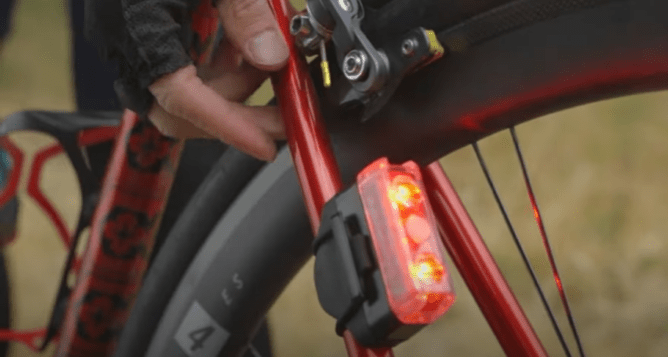

You may have thought that bicycles are exempt from safety regulations, but the truth is that in many countries, including the United States, it is mandatory to use rear lights on your bike to avoid facing a hefty fine.
In Spain, the General Directorate of Traffic has regulations regarding bicycle lighting, which state that “the bicycle’s lighting system must necessarily incorporate a red position light and a retro-reflector of the same color, not triangular.”
Previously, flashing lights were not permitted on bicycles by this regulatory body. However, in 2018, everything changed as it was claimed that these lights increased the cyclist’s visibility, and they were allowed.
Most bicycles come from the factory with a retro-reflector, which is usually made of plastic material. When car lights hit it, the retro-reflector is capable of incandescence, making the cyclist more visible.
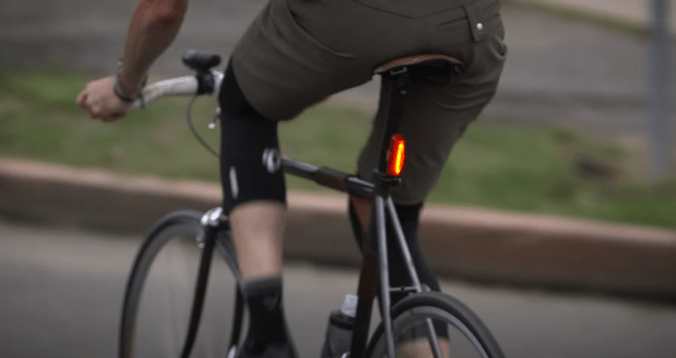

In order to keep your taillights functioning properly, regular maintenance is necessary, especially if you frequently ride in wet or muddy conditions.
Even though many taillights are waterproof and have a sealed finish, it is still important to dry them off when you reach your destination. This is because they contain electronic components that can be damaged by moisture.
When riding in muddy or dirty conditions, it’s likely that some of that grime will end up on your taillights. To prevent it from sticking, clean the lights as soon as possible after your ride.
If your taillights can be recharged via USB cable, make sure to clean the port often. Dirt and debris can block the charging pins and prevent them from working correctly.
When recharging the lights, it’s recommended to use a computer or a portable charger. Be careful when using a mobile adapter, as it may exceed the current capacity that the lights can handle.
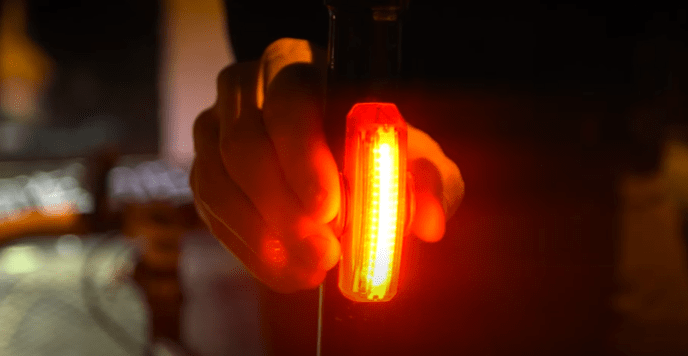

Using lights on bicycles to increase visibility seems like common sense, but the science behind making lighting design decisions and safety recommendations can be confusing.
There are very few bicycle-specific safety studies funded by independent organizations or manufacturers, and some of the studies that guide the manufacture and use of light are not relevant to bicycles.
The idea of using lights during daylight hours comes from the car industry, but it’s unclear if the results hold true for cyclists. Research on daytime running lights for cyclists is sparse.
A 2012 Danish study found that cyclists who used lights all the time had a 5.9% chance of being involved in an accident, while cyclists who did not use lights all day had an 8.4% chance of being involved in an accident. However, this study was based on surveys and may not be reliable.
When it comes to headlights, there is debate about which light mode is best for driving. Flashing headlights are often reserved for emergencies and are illegal in some cities, but some people use them because they seem to attract more attention. However, research on specific patterns of flashing that could be effective for visibility purposes is lacking.
According to one researcher, both regular interval patterns and flashing irregular patterns have had the same success rate. However, visibility depends on the duration of the flash, with longer and shorter flashes being more effective than strobe flashes.
The Society of Automotive Engineers recommends that hazard lights flash between 60 and 240 times per minute, which is the optimal range for visibility.
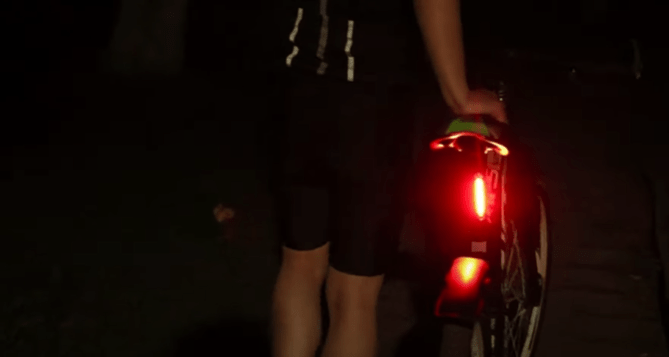

In order to increase visibility and ensure safety while cycling, it is important to use both front and rear lights. While a front light is used for seeing the road ahead, a rear light is used to make the cyclist visible to traffic approaching from behind. Thus, having a powerful and USB-charged taillight is recommended.
When selecting a taillight, it is important to consider not only the brightness but also the side lighting for urban areas where drivers may be passing. Additionally, the mode range should be considered to conserve battery life and offer different options for different riding conditions. Many manufacturers are now offering taillights specifically designed for daytime use with increased brightness.
Charging a rechargeable taillight via USB is the best option and is available on most mid-range and higher-end lights. A secure mount that easily fits the saddle, whether round or aero-profiled, is also important to ensure that the light stays in place during cycling.
How to Attach a Taillight to a Road Bike?
Mounting the taillight on the seat post can be difficult, so it’s best to use a mounting system with silicone or rubber straps that can fit on posts of all shapes and sizes. If the straps break, replace them instead of attempting to fix them yourself. Alternatively, you can secure your rear lights under the saddle, but ensure that there are holes wide enough for the light to shine through.
What’s the Recommended Number of Lumens for a Bike Taillight on the Road?
An LED light is an excellent choice for additional illumination on the road. When selecting a taillight, keep in mind that any power over 70 lumens is considered very bright and provides ample visibility to other drivers. However, it’s important to avoid mounting the light pointing skyward at 45 degrees, as some lights may not shine past themselves and onto your bumper. There are various colors available, so choose the one that best suits your bike – blue promotes relaxation, while red warns others about hazards ahead, and yellow indicates turn signals clearly from a distance.
Is It Necessary to Use a Taillight During the Day?
Absolutely! This is particularly important for cyclists in urban areas. In fact, 80% of accidents occur during the daytime, and bright taillights will help you be visible to other drivers or pedestrians who may cross your path at any time. It’s advisable to get a light with a flashing mode to ensure it can’t go unnoticed when needed most, such as when turning onto traffic from an alleyway where visibility is poor.

